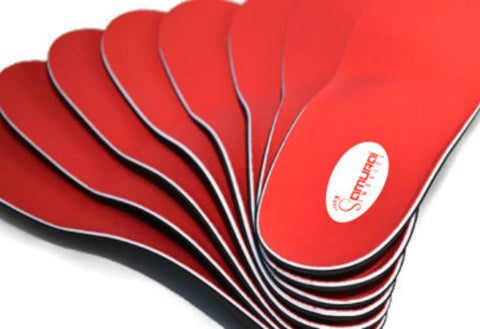
In the United States alone, approximately 2 million Americans suffer from heel pain each year. Heel pain is typically located on the underside of the heel, and occasionally behind it.
While this is rarely a symptom of a serious health condition, it can escalate to the point where normal activity, especially exercise, can be extremely painful.
Although mild pain in the heel area can commonly disappear on its own, severe pain can become persistent and chronic if ignored.
The human foot and ankle are strong mechanical structures comprising of 28 bones, more than 30 joints, and over a hundred tendons, muscles and ligaments.
The unique anatomical structure of the feet facilitates complex movements needed for balance and motion. The primary function of the heel, and the soft tissue surrounding it, is to provide strong but flexible support to bear the weight of the body.
Physical activities, such as walking, running or dancing, can put a considerable amount of strain on the foot every time it hits the ground.
The heel and its surrounding soft tissue absorb the sudden shock of the impact and help to maintain fluidity in movement.
Shoes and sneakers can augment the heel's ability to deal with these forces. For many people, orthotic insoles (also know as over-the-counter orthotics, prefabricated orthotics, or over-the-counter insoles) can provide even greater support and benefit than shoes alone.
Causes Of Heel Pain
From simple physical activities, such as walking and standing, to more strenuous weight-bearing exercises, such as dancing and jogging, the feet are constantly subjected to significant stresses. Due to their strategic location and function, the heel is vulnerable to damage, injury and pain.
One of the most common causes of heel pain is overuse/ repetitive exertion with inadequately supportive shoes. In some cases, increased body weight, the shape and flexibility of the persons foot, or the activity being performed, can neutralize the benefits of an otherwise supportive shoe.
This can lead to the most common type of heel pain: Plantar Fasciitis. This type of situation is where an over the counter insole can often excel in providing support and relief.
Plantar Fasciitis

Often referred to as the "Jogger’s heel", plantar fasciitis is the most common cause of heel pain. It has been estimated that about 10 percent of people will suffer from the condition at least once during their lifetime.
The plantar fascia is a flat band of connective tissue that connects the heel bone to the toes. This ligament provides support to the arch of the foot. Excessive stretching and repeated straining of the ligament can cause small tears in the tissue, leading to inflammation and swelling.
Supportive shoes can prevent this in some cases, while in others orthotic insoles are useful in reducing this repetitive straining action.
The pain associated with plantar fasciitis is usually experienced on the underside of the heel and is most intense when taking the first few steps after waking up in the morning or sitting for long periods of time.
The condition is very common in middle-aged people, however children and the elderly can also develop specific types of this condition for their age.
Plantar Fasciitis is often seen in people with a flat foot shape, or those who exhibit "overpronation". Overpronation is the technical term describing the abnormal way the foot functions when the arch has flattened too much with activity.
While feet should roll slightly inward with each step (pronation), rotating too far (overpronation) in that direction can cause a misalignment of the hip and knee, and a loss of shock absorption.
Other causes of Plantar Fasciitis include:
- Obesity
- Prolonged periods of weight bearing such as excessive standing, particularly on hard flooring or surfaces
- Repetitive high impact activity, such as walking or running
- Ill-fitting or worn-out footwear with poor shock absorption and support
- Stiff muscles and tendons of the foot and/or calf
- Inward or outward turning of the heel
Achilles Tendinitis
The Achilles tendon connects the heel to the back of the leg. This tendon is used heavily during high-impact exercises, such as running, racquetball or tennis. Sometimes, due to overuse, the tendon and its surrounding structures can become inflamed at its attachment to the back of the foot, resulting in heel pain.
Bursitis
Bursae are tiny fluid-filled sacs that act as cushions between muscles, joints and tendons in the feet. Excessive pressure or prolonged movement can lead to inflammation of the bursae located behind the heel thus causing pain.
Heel Spur
Inflammation due to an underlying condition, such as tendinitis or plantar fasciitis, can lead to an outgrowth of bone on the bottom, or the back, of the heel bone. This is classically referred to as a "heel spur". It is increasingly accepted that only in rare instances does the actual spur of bone cause pain. It is more likely the initial condition that lead to the growth of the spur in the first place that actually causing the patient's pain.
Tarsal Tunnel Syndrome
When the tibial nerve in the back of the foot is compressed or pinched it can lead to tarsal tunnel syndrome. Possible causes might be overpronation, inflammation in the area or chronic diseases, such as diabetes or arthritis.
Stress Fracture
An uncommon cause of heel pain, stress fracture of the heel bone or calcaneus usually develops as a result of rigorous sports, exercise or prolonged weight bearing. Long distance runners are most likely to suffer from a stress fracture.
Sever’s Disease
This is a very common heel injury in growing children. Sever’s disease is a painful bone condition that develops as a result of repetitive trauma on the growth plates of the heel bone.
Inflammation Of The Heel Pad
Sometimes, the heel pad can wear out due to heavy impact, obesity, or advanced age. This can also lead to chronic heel pain. In addition, other possible causes of heel pain include bone contusion (bruise), gout, bone cysts and tumors, rheumatoid arthritis, osteomyelitis and neuromas.
Symptoms Of Plantar Fasciitis
The typical symptoms of plantar fasciitis present themselves gradually. In most cases, pain is felt on the bottom of the heel. Discomfort can also extend into the arch. The pain is most intense when resuming activity after rest and tends to decrease with continued motion. Plantar fasciitis can also worsen at the end of the day after long periods of standing or walking. Swelling, inflammation and stiffness are other symptoms that may be associated with this type of heel pain.Relief From Plantar Fasciitis
The American Orthopedic Foot and Ankle Society has recommended the use of over-the-counter insoles and stretching exercises as a starting point for heel pain treatment.
According to one study performed, approximately 95 percent of women who wore over-the-counter insoles and followed a simple stretching regimen experienced significant relief from heel pain in eight weeks.
This illustrates what many have experienced in the past, that over-the-counter insoles can be used as a highly effective first line of therapy for heel pain with positive results.
Upon a thorough history and examination, a podiatrist or orthopedist may recommend a treatment plan combining insoles with some of the following:
- Stretching exercises and rest
- Shoes that provide support and can reasonably accommodate an OTC insole
- Night splints
- Non-steroidal anti-inflammatory drugs for pain relief
- Physical therapy sessions to stretch and strengthen the heel, ankle, and calf
- Corticosteroids
- Extracorporeal shock wave therapy
- Surgery may be recommended in rare cases
Choosing The Right Orthotic Insole For Heel Pain
- All insoles for heel pain are not created equal! There is a wide variety of materials, designs, and quality when it comes to this industry, often making the buying process frustrating. It's important to be an informed consumer.
- Well-designed insoles can provide the arch with firm, yet comfortable, support. It is important to strike a balance between ‘cushiony’ and rigid. Insoles that are too rigid are unable to compress adequately during activity, failing to absorb the shock from constant impact. Due to this, rigid insoles can sometimes lead to pain in different areas of the foot, leg, or even body.
- While soft and squishy insoles may feel very comfortable at first, they typically do not provide enough support and stability in the long run. Often, tension across the plantar fascia is not adequately reduced with these types of insoles.
- Finding the right size matters. It is best to purchase insoles that are sold in actual shoe sizes to ensure that they serve their purpose. Insoles need to fit as closely to your shoe size and arch as possible for maximum effectiveness. Insoles manufactured in a small, medium, and large sizing scheme often provide a suboptimal fit.
- A podiatrist can also suggest the most suitable over-the-counter insoles for your individual requirements. Some individuals do require a custom foot orthotic to be fabricated to fit their unique support needs.






